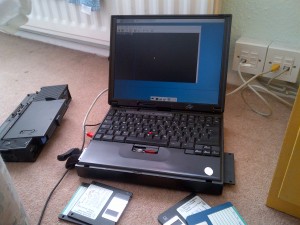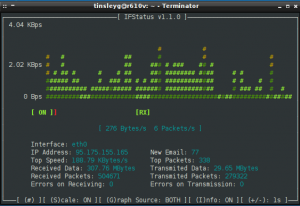Intro:

I ordered this nifty ‘RFduino’, an arduino-compatible device which was also my first ever kickstarter purchase over a year ago now.
However, when the device arrived, the company behind it seemed exclusively interested in the iPhone handset to the detriment of all other platforms.
Personally, the lock in monopolistic attitude of Apple and its customers really gets my goat, but I digress.
The lack of support and that the device arrived half a year late left me with a sour first taste of Kickstarter.
Since then, I’ve played with the Rfduino using JT’s iGear (no, I don’t know why fell into the Apple pit either) using the only app available to use the sketch it comes with – the internal thermometer
But that’s rather limiting!! I bought this device with plans to build a Wireless ‘Internet of Things’ sensor network for my house.
I have designs on talking to every platform available using protocols such as mqtt, backends like rrdtool and web interfaces for my housemates to see and control the action.
This is something I’ve been dreaming and sketching out for years, because lets face it, who doesn’t think having the lights turn out when you leave is super cool?
So without further ado, how do we get the RFduino to talk to a linux machine, in my case a Raspberry Pi running Raspbian.
Ingredients:
Hardware:
You will need
- Internet connection to download tools
- Bluetooth packages installed (bluez-tools)
Howto:
Power on the RFduino and linux machine. I used two Alkaline AA batteries to power the RFduino although Rechargeables do work.
Install the Bluetooth 4 usb adaptor on the linux machine
Install the necessary bluetooth programs:
sudo apt-get install bluetooth bluez bluez-utils bluez-firmware
(you may need to reboot the machine afterwards, I don’t believe I did)
Bring up the bluetooth interface:
sudo hciconfig hci0 up
Run a Low Energy scan to find the address of your RFduino:
sudo hcitool lescan
Should elicit results similar to this:
EA:BA:20:48:37:80 (unknown)
88:D8:CD:08:12:FA (unknown)
99:D8:CD:10:66:FA (unknown)
DD:AF:13:17:23:80 RFduino
Select and copy the MAC address given for the RFduino on your system.
(I have no idea why you have to scan as root, someone please leave a comment if you do, and if theres a way to run as a normal user…groups?)
Read the temperature attribute from the RFduino using gatttool. Paste your devices MAC address in instead of mine of course.
sudo gatttool –device=DD:AF:13:17:23:80 –interactive
[ ][DD:AF:13:17:23:80][LE]>
[ ][DD:AF:13:17:23:80][LE]> connect
[CON][DD:AF:13:17:23:80]][LE]>char-read-uuid 2221
[CON][DD:AF:13:17:23:80][LE]>
handle: 0x000e value: 00 00 a8 41 00 00 00 00 00 00 00 00
[CON][DD:AF:13:17:23:80][LE]>disconnect
[ ][DD:AF:13:17:23:80][LE]>quit
Now from that exchange with the RFduino, we have gained a long hexadecimal string.
From a post on the RFduino forum, I learned that the value we want is always after the ’00 00′ string (in bold above).
This is the temperature read from the RFduino’s internal sensor * 8.
So we need to convert this to Decimal and divide by eight to retrieve the temperature value in celsius (American readers, why aren’t you on SI units yet? :P).
Convert the hex value to decimal temperature
decimal=$((0xa8))
decimal=$(($decimal/8))
echo $decimal
21
The above method returns an integer value. This is because Bash has limitations working with numbers that are not whole (decimals).
Workarounds use the command bc to interpret string inputs as decimal numbers. I think there is a method to define variable types in bash, but I didn’t get very far with this.
My attitude is that once you start hitting the limitations of a shell scripting language, it’s time to migrate to a proper programming/interpreted language (at least python).
Spending hours and using multitudes of additional programs make it work is often pointless.
Just think, if you had to run the script on a embedded system without most of those commands, wouldn’t it just be better to do it in C++?
Next time:
Now that I’ve successfully read the values being sent by the RFDuino I need to figure out how to automate the process – in non-interactive mode.
These commands do the same thing but respond differently
sudo gatttool -b [MAC] –char-read –handle=0x000e
Characteristic value/descriptor: 00 00 a8 41 00 00 00 00 00 00 00 00
sudo gatttool -b [MAC] –char-read –uuid=2221
handle: 0x000e value: 00 00 a8 41 00 00 00 00 00 00 00 00
Simple bash script to read temperature in celsius (accuracy is lost here as the decimal is converted to an integer)
#!/bin/bash
stringZ=$(gatttool -b [MAC] –char-read –handle=0x000e)
stringZ=${stringZ:39:2}
hex=$((0x$stringZ))
decimal=$(($hex/8))
echo $decimal
exit
don’t forget:
chmod +x [whatever you called the script]
and run it as root:
sudo [whatever you called the script]
Afterword:
I won’t pretend to understand the naming conventions of Bluetooth 4.0/LE.
I don’t! I spent a whole day looking into it and could not find a single source that easily explained the structure, naming, and profiles. If someone has seen something good, please post in the comments!
It’s frustratingly close, like I can see there is a neat logic to it, but I just don’t care to spend any more time trying to figure it out, when all I want to do is use it. This does make it slightly more hacky and less neat and quick of course, but that’s life!
Sources:
gattool commands to read the sensor:
http://lilyhack.wordpress.com/2014/02/03/ble-read-write-arduino-raspberry-pi/
howto convert hex to decimal on the command line:
http://linuxcommando.blogspot.co.uk/2008/04/quick-hex-decimal-conversion-using-cli.html
howto do calculations on the command line:
http://www.tldp.org/LDP/abs/html/arithexp.html
Hacked up way of using gatttool non-interactively, using ncurses and a python script:
http://thomasolson.com/PROJECTS/BLE/RFduino/LINUX/
Bash string manipulation:
Bash String Manipulation Examples – Length, Substring, Find and Replace
Others:
http://joost.damad.be/2013/08/experiments-with-bluetooth-low-energy.html














